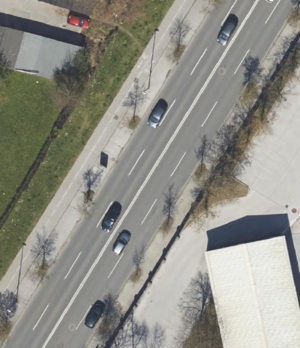Talk:Dual carriageway
"Exception"
"However, if a road contains any of the non-appropriate elements and is still separated by a physical obstructions along other parts of the road within at most 1 km of the surrounding obstructions, then the road should continue to be mapped as a dual carriageway. These exceptions are typically easy to recognize and and should be mapped in-thought of ease of recognition, routing, presence, and functionality of the road. Other exceptions have been made for dual carriageways such as roads like Super twos found in the U.S. " Why should that be the case? For the former, it's more about subsequently refining the level of detail. For the latter, this is in conflict with the physical separation definition; when change=no etc can be used. ---- Kovposch (talk) 08:00, 5 May 2021 (UTC)
- Then what should it say? --Lectrician1 (talk) 15:35, 5 May 2021 (UTC)
Double-marked centre lines
In many cities, there are primary and secondary highways with 2 or more lanes for in each direction which are not separated physically, but only with double centre lines (and occasionally wider dashed no-traffic areas). Should these be mapped as one highway or as 2 parallel highways. The wiki article is currently somewhat ambiguous about this situation.
The article currently says: Dual carriageways are not appropriate for roads that have no physical separation. This would speak for only one highway. However, it goes on to say: For example, roads with single-marked centerlines, [...]. This seems to imply that cases with double-marked centre lines should be mapped as dual carriage ways.
I don't have any preference for any, but I'd prefer if there is a community standard that I can adhere to. Any opinions? Martianfreeloader (talk) 19:11, 30 December 2021 (UTC)
- @Martianfreeloader You should not use 2 highways in that situation. Before "For example, roads with single-marked centerlines..." it says "Dual carriageways are not appropriate for for roads that have no physical separation." so those following examples are things that should not use 2 highways. Lectrician1 (talk) 04:23, 31 December 2021 (UTC)
- Use
change:lanes:forward=not_left|yes+change:lanes:backward=not_left|yes. Kovposch (talk) 10:27, 31 December 2021 (UTC)- Thanks, I've clarified that. Martianfreeloader (talk) 11:45, 5 January 2022 (UTC)
“Paint”
What is the rationale for the “Roads are not to be mapped as dual carriageways if the two directions are only separated by paint” rule?
It seems to me that the point of separation is to make it clear to navigation services that one can’t get from an address on one side of the road to an address on the other side. In which case, the material of the median shouldn’t make a difference.
TBH I’m having a hard time coming up with a rationale that does need to distinguish based on materials, hence this question. Thanks. Vectro (talk) 13:49, 10 April 2024 (UTC)
- The material does make a difference. If a road is separated by a double yellow line (paint), then vehicles can cross it to get to the other side of the road. If the road is separated by a physical median, they cannot cross, and thus it should be mapped with 2 different ways. Lectrician1 (talk) 14:12, 10 April 2024 (UTC)
- But, if a road is seperated by hatched areas, then vehicles cannot (legally) get to the other side of the road. So that cannot be the only factor. Consider this section from Wikipedia:
In some areas such as California, highway medians are sometimes no more than a demarcated section of the paved roadway, indicated by a space between two sets of double yellow lines. Such a double-double yellow line or painted median is legally similar to an island median: vehicles are not permitted to cross it, unlike a single set of double yellow lines which may in some cases permit turns across the line. This arrangement has been used to reduce costs, including narrower medians than are feasible with a planted strip, but research indicates that such narrow medians may have minimal safety benefit compared to no median at all.
- It seems that an island median would be mapped with dual ways while a painted median would use single ways, even though they are legally the same. Vectro (talk) 14:24, 10 April 2024 (UTC)
- (1) In OSM, we do not (only) map the legal situation, but the actual physical situation. Information about legal restrictions is usually added in the form of tags, not individual objects. (2) Emergency vehicles can cross the paint, but not a physical median. --Martianfreeloader (talk) 18:53, 10 April 2024 (UTC)
- This is complicated and error-prone when connecting all roads across them, and handling all restriction=* correctly. Believe me, I have seen quite a few examples of (wrongly) splitting, and not connecting all the side roads across properly. You also need to allocate all route=* on them.
- Please see how it's done in overtaking=* , change=* , *:lanes:both_ways=* (especially Key:lanes:both_ways#Examples File:HillsideRdCaversham.jpg where LHT NZ allows using and turning right across the solid border diagonal hatching)
—— Kovposch (talk) 22:46, 10 April 2024 (UTC)- @Kovposch: can you clarify which modelling scheme you're referring to by This? Mapping as single (current community consensus) or as dual ways (the scheme discussed here)? --Martianfreeloader (talk) 16:13, 11 April 2024 (UTC)
